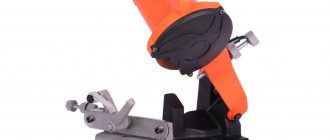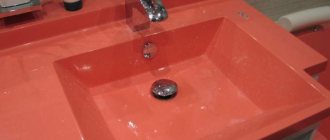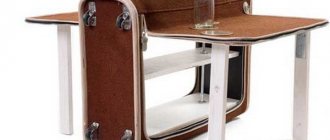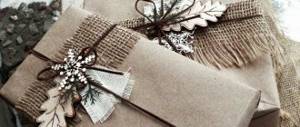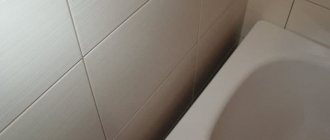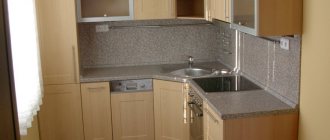Do we edit or sharpen?
Sometimes sharpening is not necessary, you just need to update the edge a little, removing irregularities and lightly grinding, which makes the knife sharper.
This is called editing.
It is done using musats, fine-grained sandpaper, or the old-fashioned way, on a leather belt.
In this case, the angle is not set, but the one that already exists is maintained.
But if you need to change or restore the geometry of the cutting edge angle, then this is sharpening.
And if you don’t maintain the right angle, then cutting will become simply impossible.
All kinds of tools
Don't know how to sharpen kitchen knives?
It doesn’t matter, there are several different ways and tools for this:
- A steel or ceramic rod called a mussate. Actually, it is made from the above-mentioned materials, on top of which a diamond coating is applied. Outwardly, it resembles a round file, only such a tool is used to a greater extent for straightening knives, rather than for sharpening.
Standard moussate, which is sold in all hardware stores
- The whetstone is the most common tool that appeared in the kitchen several decades ago. Stones differ in grain size; coarse (large grains) are intended for leveling the angle and correcting the shape of the cutting part. Medium grains are used to restore the original shape at the edge, and fine-grained stones are used to finalize the knife to working condition.
- Sandpaper can replace the whetstone. Unfortunately, it does not sharpen so well, so it is best to use only fine-grained blades. They will not damage the product or disrupt the edge angle. But this is the cheapest sharpener for kitchen knives.
- A special device that has become very popular in modern times is a plastic case with metal disks built into it. If you insert a knife between them and make several movements back and forth, you can not only correct the edge, but also eliminate defects. The main advantage of such a device is that it maintains the correct sharpening angle of kitchen knives, which is 10-20 degrees.
The most common device that can be easily edited by a dull knife
As you can see, you can restore the knife’s former sharpness on your own without any expense. And if you don’t know how to properly sharpen a kitchen knife, then the entire process of sharpening and straightening will be described in detail below.
Another semi-professional device that can restore your knife to its former sharpness
A few words about laser sharpening and self-sharpening steel
Some are afraid to sharpen knives at home, because they believe that now workshops offer almost nanotechnology, as a result of which the blade will remain sharp longer. We are talking about laser sharpening, as you understand.
So: this is a myth and marketing.
The laser does not sharpen absolutely anything, the beam simply indicates the correct angle (just like on a laser level to determine the plane). But it sharpens an ordinary stone, so there is nothing special in such a procedure.
Self-sharpening steel is also a fantasy.
Absolutely everything gets dull, but the higher quality the alloy, the longer the knife lasts. Therefore, there is no point in wasting money on such knives; it is better to buy a good sharpener for ordinary ones.
What other ways are there to sharpen a kitchen knife?
Many people are interested in how to properly sharpen a kitchen knife using sandpaper. But this is not the only alternative to bars. In addition, you can sharpen a kitchen knife on a sharpener. These methods are suitable for any type of blade. For simple utensils, you can use an electric sharpener. It is safe, even a beginner can use it.
Before sharpening a kitchen knife using an electric sharpener, you need to find out the pros and cons of this method. The main advantage is that an electric sharpener quickly sharpens knives to the desired sharpness.
The disadvantage of this unit is that it removes a lot of steel from the blade. The knife will last less than this model is supposed to. Electric models are unreasonably expensive; not everyone can afford such a purchase. The simplest option costs from 6 thousand rubles.
An inexpensive option is a roller blade. It is easy to use for people who have never tried sharpening knives at home before. The work goes quickly. The blade will remain sharp for a long time. The Fiskars sharpener has proven itself well.
What knives cannot be sharpened yourself?
Let's start with the most important thing: which knives cannot be sharpened?
If you are doing this for the first time, then you cannot sharpen your favorite and convenient knives.
An incorrect sharpening angle can completely ruin the blade, therefore, it is better to experiment with something simpler, so that you can safely throw it away and not be annoyed.
You should not sharpen ceramic knives yourself with ordinary whetstones. Only diamond takes ceramics, and if you don’t have such a stone, then it’s better to give the knife to a professional.
But if there is, then you can try to sharpen it yourself, since the technology for sharpening a ceramic knife is no different from sharpening steel blades.
Knives made of Damascus steel and damask steel - on the contrary, sharpening on a diamond stone is strictly not recommended, as the blade may crumble.
It is better to give it to a master, since grinding such steel with an ordinary whetstone is not a task for the faint of heart: it is a long process.
Also, you should not sharpen knives with a wavy edge at home. Moreover, there is no point in taking them to the workshop either, since it is simply impossible to return the saw knife to its original properties.
It’s easier to buy a new one or resharpen it to a regular one.
Types of knife sharpeners: their advantages and disadvantages
It turns out that choosing a good sharpening tool is not so simple: not only are there a large number of types, but each has its own characteristics. The main thing here is to understand which option is suitable for specific knives and skills. The main thing is not to try to find a cheaper product, because in this case, no matter how much effort you put in, even the highest quality blade will not return its original sharpness. What types are there?
Musaty
They are easy to recognize because they look like a thin and long file with a round cross-section. An easy-to-grip handle is made in the lower area of the musat. They are suitable for minor adjustments to the blade in everyday life, helping to maintain a decent level of sharpening, so keep them in your nearest drawer so that you always have them at hand.
Disadvantages: If the knife is in disrepair, you need to look for more effective methods. And the result will not please you for a long time - a couple of days, and you already feel that you will have to put in a lot more effort during cutting.
Mechanical machines
They can also be used to sharpen kitchen scissors. The system is quite simple - the knife is manually held with quick movements in a special recess in the body, the process is done manually. Only here you need to be careful and choose the sharpening angle and optimal speed yourself. Mechanical models are mostly universal, suitable for both left- and right-handed people. The presence of the Soft Touch function increases the safety of use, since the case does not heat up.
It is worth noting the low cost of mechanical sharpeners. They are also compact and easy to take on a trip or hunting. Stainless steel is used to develop the blade, which has a long service life. The body is made of wear-resistant plastic or rubber. Much attention is paid to aesthetics; bright and multi-colored inserts are made in the body. It is possible to find multifunctional models, with sharpening levels for different types of blades: stainless steel and ceramic.
Disadvantages: Although the speed is guaranteed, just as quickly the blade will become dull again, and you will have to take out the sharpener again. And not every model guarantees high-quality sharpening of products.
Electrical machines
With such a device it is much easier than with mechanical analogues. In this case, the angle is selected automatically, and the device can handle even the most dull knives. It is suitable for a large number of tools, ranging from knives with any type of blade, to screwdrivers and kitchen scissors.
A couple of minutes - and you have a device in your hands, sharpened and polished to perfection, the main thing is not to forget to follow the instructions. When choosing, you should pay attention to the rotation speed, power and grain size of the disk. Quiet work is in demand so as not to disturb others and not to experience discomfort. After use, the electric sharpener will not require much effort to maintain.
Disadvantages: The only disadvantage of electric models is that not everyone can afford them, especially if you don’t skimp on power and speed characteristics. Also, many people remove a lot of steel when sharpening, so get ready to go get a new knife soon.
Sharpening stones
When choosing such models, you need to be more careful, because the stones differ in different degrees of grain size according to the ANSI, FERA, GRIT and others. You should also often look for two bars at once - for sharpening and subsequent grinding, with small and large grains, respectively.
Sharpening stones are divided into several types:
- Diamond. They are expensive, so they are worth buying for those who have already gotten their hands on this skill. The base is made of aluminum or plastic, and on top there are metal platforms with diamond grains. In this case, you don’t have to purchase two, because one surface is designed for sharpening, the other for grinding.
- Japanese water stones. Also quite expensive, in the process they form a suspension that provides polishing. They do not have a very long service life.
- Ceramic. This type is widely used because it is budget-friendly, convenient and will last for many years, although over time it will wear down noticeably and lose its shape.
- It is worth noting that natural ones are most often fine-grained, therefore suitable for grinding, while artificial ones are made with different characteristics, which may even differ on the sides of the product.
Abrasive or felt wheel
If all past products are available to everyone and do not require skills, then these models can only be entrusted to professionals, so you need to take the knife to the workshop. An experienced specialist knows to what temperature the steel should be heated, because if it gets too hot, it will only damage the knife. The result is surprising; the blade becomes sharp, just like in the first days of purchase.
Disadvantage: Although a professional approach is provided, there is also a disadvantage - the knife does not remain sharp for as long as we would like.
These are only the most popular methods that are often and widely used. There are also clamps with stops designed for beginners, which help maintain the sharpening angle during the process. There is sandpaper that is quite cheap and not very effective, but suitable for minor adjustments.
What to sharpen with? We are considering options
There are many tools for sharpening knives, ranging from electric ones to regular whetstones, which are very inexpensive.
Electric sharpeners
Electric sharpeners have two big disadvantages: the expensive price (around 10,000 rubles) and the ability to remove steel heavily during sharpening, which leads to rapid wear of the knife.
But the process is fast, fully automated and there is no need to manually maintain the degree of inclination when sharpening.
How to sharpen a knife on a sharpener is usually written in the instructions that come with the device.
Musat
Musat is a good thing, but it won’t sharpen a very dull knife, since it is mainly intended for straightening. And the effect of such sharpening lasts for a couple of days at most.
How to sharpen a knife with musat is shown schematically here:
Roller blade
Not a bad option for women. Just a couple of movements on the rollers and the knife cuts well (but not for long). They are inexpensive and everyone can afford them.
Sandpaper
Sharpeners are skeptical about using sandpaper for these purposes. But the practice of those who use it convinces us that this is a completely acceptable option.
This is not to say that it is the most comfortable, but if you don’t have anything at hand, and you need to sharpen the knife urgently, then you can use sandpaper. Moreover, the article is not for masters, but for amateurs.
Sandpaper strips must be secured to any wooden base (in the form of a block) using tape. On the one hand - the coarse-grained fraction, on the other - the fine-grained fraction.
Ceramic bar
It’s not worth talking about the price here, since they are very cheap. The main thing is to choose it correctly so that you can sharpen it comfortably later.
You need two bars. One with a rougher surface (320 grit), for basic sharpening and edge angle correction, and the second for surface grinding (1000 grit).
The length of the stone should be approximately the same as the longest knife in the house.
Width – the wider, the more convenient it is to work with it. You can read how to sharpen knives with a whetstone below, in a separate block.
Diamond block
Diamond bars don’t cost five kopecks, but the result cannot be compared with an ordinary stone. It’s more comfortable to work with, and it’s also more durable.
It consists of a plastic or aluminum base, onto which two metal plates coated with diamond grains are attached.
Such bars do not wear off like ceramic ones and even after repeated sharpening they remain smooth, rectangular in shape with sharp corners.
In addition to all these advantages, there are also advantages:
- They are not afraid of impact and will not break if accidentally dropped
- The diamond block is not clogged with steel particles. After sharpening, you only need to rinse it lightly under water and wipe it clean.
- The sharpening process on diamond stones is very fast, which means that the stone will serve you for a very long time, as it hardly wears down
- You don't need to buy two bars, as they are made in such a way that one side is rough and the other is for sanding.
There is only one drawback to diamond stones – the price. They are not cheaper than 800 rubles, and if they are, then they are clearly a fake, which will become unusable after five sharpenings.
Japanese water stones
A water stone is also a block. But it should not be used dry, but moistened with water.
During the friction process, a suspension is formed, which simultaneously with sharpening polishes the surface.
They are not cheap, but they wear out quite quickly. So, for simple kitchen knives this is not the best choice.
Sharpening using an abrasive wheel on a drill or machine
You should not do this if this is your first time sharpening a knife.
A couple of seconds is enough to cause irreparable harm. Moreover, in this case the steel gets too hot and it is necessary to cool it during the process, and if this is not done, the edge may crumble.
How to properly sharpen knives on a machine is the topic of a separate and extensive article, therefore, we will not focus on this here.
Also be sure to watch this video, it is very on topic.
Since, in this matter, it is better to see once than to hear a hundred times!
Types of knives
Before you start sharpening a knife, you need to decide what its blade is made of and for what purposes the cutting tool will be used. After all, the method, choice of tool, sharpening angle and other important subtleties of returning sharpness to the blade will depend on these factors.
According to blade material
Knives are made from the following materials:
- Carbon steel. These are the most affordable knives and are characterized by hardness. An alloy of iron and carbon is used to make them. After sharpening, the cutting edge remains sharp for a long time. The disadvantage is that it is susceptible to oxidation upon contact with food.
- Stainless low carbon steel. Such knives are inferior to previously discussed analogues in terms of resistance to mechanical loads. For this reason, the cutting tool needs to be sharpened more often, which leads to rapid wear of the blade. They are made from an alloy of iron and carbon with the addition of chromium. Sometimes molybdenum or nickel is used in manufacturing. The advantage is resistance to aggressive substances.
- High carbon stainless steel. The material is an alloy of iron with high concentration carbon and additives (cobalt, vanadium). This type of tool is resistant to corrosion and is quite hard.
- Damascus steel. These knives have a multi-layer blade. They are durable and have one drawback - high price.
- Ceramics. Such knives cannot withstand bending loads and are damaged when dropped. However, they can remain sharp for a long time.
By purpose
A knife is a universal cutting tool that is used in almost all areas of activity.
Kitchen
Meat knife.
Special cutting tools should be used to process and cut different products. This makes the job easier. The blades of different knives differ in the angle and type of sharpening. This means that the angle of the blade changes up or down. Thanks to this feature, the structure of the product can be better preserved when slicing. For this reason, separate knives are used:
- for meat;
- for vegetables;
- for pizza;
- for cakes;
- cheese;
- bread;
- chef knife
Kitchen knives differ in the shape, width and thickness of the blade. Some of the varieties are serrated.
For hunting
Hunting tool requirements:
- strength;
- presence of a comfortable handle;
- minimum guard sizes;
- high-quality steel intended for hunting;
- blade width – from 3 mm or more;
- strength index – 58 HRC;
- standard length – from 10 to 17 cm.
Other types
There are:
- combat models, used by special services and in the army;
- folding - used for invisible carrying, certain types of such knives are used in tourism;
- for surgeons;
- for divers;
- stationery knives;
- dining rooms - for table setting.
About sharpening angles and methods of fixing the blade
But no matter what stone you choose, the sharpening technology is the same. And this is the main thing you should learn.
To begin with, train on the simplest ceramic bar, and when you see what you can do, buy something more expensive.
The most important thing in the sharpening process is to return the original angle of the edge. For kitchen and home knives it is usually standard: from 25 to 45 degrees.
Moreover, the lower the degree, the thinner the cutting edge becomes. Yes, the knife will be sharp, but it will also dull much faster, and also lose its edge shape as soon as it touches something hard.
So, if you want to resort to sharpening as little as possible, you should not make an angle of 25 degrees.
A knife that is too sharp is a rather traumatic thing in everyday life.
It will cut well not only vegetables and meat, but also kitchen towels along with your hands at the moment you wipe it.
Here is a table of recommended angles:
And here, pay attention to the fact that the angle in the table is indicated as full, that is, it is the sum of the two sides of the edge. And if you want to sharpen a knife by 30 degrees, then you need to remove 15 degrees from each side of the blade.
Accordingly, if you need an angle of 45 degrees, then remove 22.5 degrees from each side.
You need to maintain this angle during the entire sharpening process, trying not to deviate from the specified value, since the final result depends on it.
Now the question is different: how to fix and calculate this angle by eye?
This can be done as shown in the picture:
After you place the paper, you will approximately know at what angle you need to hold the knife.
Well, now let's move on to the sharpening process itself.
Sharpening tools and their uses
Devices and special tools differ not only in the principle of operation, but also in the quality of sharpening. Electrical appliances operate much faster. However, you need to work with them carefully, because inattention can lead to a chef's or hunting knife being sharpened with a change in the position of the blade relative to the working surface. As a result, the service life of the product will be significantly reduced. To sharpen knives at home, mechanical tools are sufficient.
Touchstone, whetstone
There are different options, differing in size and number of abrasive grains per 1 mm². The quality of sharpening will depend on this. If you need to sharpen a knife on a whetstone, you first need to decide whether rough or fine grinding is required. When choosing such a tool, you need to pay attention to the markings. It is applied directly to the surface of the bar. However, there is no such information on domestic donkeys, so you will have to find out about the parameters from the seller.
The bars are found in different versions, differing in the type of spraying:
- diamond;
- silicon carbide;
- electrocorundum.
If there is no information on the type of abrasive on the whetstone, you can try to determine its type by touch. To do this, you need to run your finger or nail along the surface of the bar.
Mechanical sharpener
This tool has a handle, which makes it comfortable to use. The blade is installed in a recess on the body, characterized by an acute angle. By making reciprocating movements, you can get the desired result. The advantages of the tool include reasonable price and the ability to be used at home. However, it is inferior in efficiency to some analogues. So, on a sharpening machine the work is done faster. At the same time, the blade remains sharp longer. Knife sharpening wheels also provide better results.
Electric sharpener
Such devices are available in different variants. A sharpener with 2 sharpening slots in the body is more effective. The main advantage of such devices is the ability to automatically determine the required angle of inclination of the blade relative to the working surface. They are used for different purposes, but are more often used in facilities where it is necessary to regularly sharpen knives on an electric sharpener. In domestic conditions, such devices are rarely used due to their high cost.
Musat
This is the name of the tool, which consists of a handle (in most cases it is plastic) and a large-section steel rod. Its main function is to maintain the required level of blade sharpness. This tool is included in the set of knives. However, users often confuse it with special sharpening equipment and devices.
It must be remembered that you cannot sharpen knives with musat if they are very dull. For this purpose, more effective means are used. This is due to the principle of working with musat and the type of material from which it is made. Thus, the steel rod is not abrasive enough, which does not allow sharpening to the required level of blade sharpness. The principle of working with musat is based on the correct execution of movements. So, the blade should be at an angle of 20°. It needs to be moved from top to bottom, so the tool is placed vertically.
Lansky sharpener
This equipment is designed for small and medium-sized knives. Its advantage is the ability to ensure the sharpness of the blade located at different angles relative to the working surface. To do this, the structural elements of the sharpener are rearranged. The tool consists of 2 angles, a small-section steel rod that holds a whetstone (touchstone). The last of the structural elements is used to sharpen the blade. The knife is fixed between two corners. Its edge rests against the whetstone.
Sharpening and grinding machines
They are circles fixed on a rotating shaft. To achieve different sharpening qualities, different abrasives are used. In order to more accurately determine the angle, a special add-on is provided, located above the grinding wheel. A blade is installed between it and the abrasive.
There are also simpler designs designed for everyday use: electrically driven abrasive wheels, rotating discs for grinding. However, regardless of the type of design, experience is required to operate the machine. This is due to the fact that the metal heats up during the sharpening process. As a result, the blade quickly fails and may crumble. In addition, in this way you can significantly change the angle of its inclination.
Step-by-step guide to sharpening a knife on a whetstone
- 1. First of all, place the block on the table so that it is convenient for you to sharpen.
You can place a kitchen towel under it to prevent slipping. There is no need to hold the block in your hands, since in this case there can be no question of controlling the angles. - 2. Moisten it with water. This is necessary for better sliding of the steel over the stone and further easy cleaning of the block from metal particles.
- 3. Place the knife across the block and start making movements away from you, as if you were sharpening a pencil. It’s best to look at the video we posted in the last block to see exactly what it looks like.
You can’t put too much pressure on the stone; it won’t speed up the process at all, but it can seriously deform the edge. Swipe one side of the block 50 times, trying to maintain the angle all the time.
As soon as you notice that a slight roughness, the so-called burr, has formed on the cutting edge, turn the knife over and sharpen the other side.
This is what a hangnail looks like:
Important! If a burr does not form, then continue sharpening. Only this unevenness will show that the steel has been ground down enough and there is no point in sharpening it further.
Once you've finished the second side, the burr may transfer to that side.
In this case, turn the knife again with the other side and sharpen. And do this until it completely disappears.
And only after this can you proceed to grinding the edge on a fine stone. Here you no longer need to move the knife 50 times, 20 times is enough.
And if you want the knife to dull less often, then you can bring the edge to a mirror shine using a regular leather belt, which is lubricated with GOI paste.
In this case, the movements should not be point down, but vice versa. That is, you also “shape” the belt, only in the other direction.
We have described the most basic method, which does not require any special costs or equipment. And there is another one, very convenient, but for it you need to build a small machine.
Here's the one in the photo:
As you can see, there is no need to hold the blade during the process, controlling the degree. The inclined and fixed block does everything for you, and the main task is to hold the knife straight, at 90 degrees.
And this, you see, is much easier than maintaining the level of 22.5 degrees (to be honest, this is an almost impossible task for a beginner, even though in theory everything sounds simple).
After all, a deviation of some micron already leads to the fact that the quality of sharpening will not be the best.
How to sharpen a kitchen knife
- Start with a coarse-grained surface on the sharpener and end with a fine-grained surface. Select the correct sharpening angle and maintain it along the entire cutting edge. Act smoothly and without pressure;
- Before, during and after work, wet the block with water or a soap solution. Then the blade will glide better, and metal dust will not clog the bar. As a result, this will increase the service life of the whetstone;
- Leave the stone in water or soap solution for 15 minutes. Then place the moistened block on a wooden board (you can use a cutting board or place it on a towel);
- Choose a suitable sharpening angle. The sharper it is, the sharper the blade will be, and the longer it will not lose its sharpness;
- Standard kitchen knives are sharpened to an angle of 40-45 degrees, fillet knives are sharpened to an angle of 30-40 degrees. To get the angle at which you need to sharpen (the angle between the blade and the surface of the whetstone), divide the selected value by two. Thus, the average sharpening angle for a standard kitchen knife is 22.5 degrees;
- Place the knife across the sharpening stone so that the top edge of the handle is under the bottom edge of the stone. Start sliding the blade along the block and maintain the selected angle throughout the entire processing process;
- Remember that movements should be smooth, do not put pressure on the blade! Run the blade along the block 40-50 times until a burr appears along the entire length of the cutting edge;
- A burr is a small roughness that is difficult to see and can only be felt. To find a burr, carefully run your finger along the edge of the blade, but not along the edge, otherwise you will cut yourself;
- During the procedure, periodically wet the bar in water to wash away metal dust;
- Once a burr appears, you cannot grind further, otherwise the excess metal will be erased. Then turn the blade to the other side and repeat the action;
- When burrs appear, you need to bring the knife to perfect condition using musat or a stone with a smaller grain size.
How to sharpen a knife in extreme conditions?
And it happens that there is absolutely nothing suitable at hand, and you just need to sharpen a knife urgently.
In this case, the following methods will help you out:
- Sharpening a knife on the corner of a concrete step in the entrance (just wash it thoroughly before doing this)
- Sharpening a knife on an ordinary stone from the street, which looks more or less smooth
- Sharpening a knife on the rough edge of a ceramic plate or regular cup
We hope that now you will have an understanding of all the ways you can sharpen any knife at home without damaging the blade or yourself.
Sharpening stone
A whetstone, or whetstone, is an almost eternal thing. It can serve for years, passed on from generation to generation. Surely, in your kitchen cabinet there is a block left over from your grandfather. Sharpening knives using a whetstone is a universal and most convenient way. It can be used in a city kitchen, on a hike and in a country house; The block is very compact. Knowing how to properly sharpen a knife with a whetstone is not something secret. It's quite simple, although it does take some getting used to and gaining some experience.
Place the block horizontally on the table (i.e., the long side should go from left to right). It will not be possible to sharpen a knife correctly with a whetstone if the table is unstable and the “stone” itself has incorrect geometry and does not lie flat.
Take the knife by the handle and place the fingers of your other hand on the blade.
Slowly and evenly move the knife along the block in a semicircular path, maintaining the angle of inclination (20–25°). Each side of the blade should take 5-7 minutes.
Master's secrets: sharpening will be smoother if you drop a few drops of oil on the block and moisten the blade with cold water.
Sharpening stone is the best choice
The bars come in different shapes and with different grain fractions. The larger the grain, the more metal it removes from the blade. Sharpening is quick, but rougher. A good sharpening stone can be expensive, and a real master may need several stones for first-class sharpening - at a minimum, with a coarse grain (for basic sharpening) and a fine one (for finishing). A good solution would be a universal block, different edges of which have different grain sizes.
Imported bars have a special marking that allows you to determine the grain size (it is measured in different units, but the general principle is the same: the larger the number in the marking, the finer the grain). Russian bars are not marked. You will have to select them “by eye”. As for quality, the bars from different producing countries are approximately equal. The price can be a guideline: the more expensive, the better the quality of the material. Diamond coated stones are the most valued.
To make the blade perfect, after the main sharpening, make several strokes on a fine-grained stone (or fine sandpaper). The video will tell you more clearly how to sharpen a knife with a whetstone.
Emery for sharpening knives
Electric and mechanical sharpeners, sharpeners and whetstones are simple tools for sharpening tools that even beginners can use. But if you are an experienced craftsman who knows how to handle tools, then you can sharpen a knife in a few seconds using regular sandpaper.
For sharpening knives, it is better to use a fine-grained wheel. Turn on the device at low speed and run the blade several times along the side surface of the circle. Don't forget about the sharpening angle, which is still 20°. The angle is especially important here, because if it is not observed, you will ruin the approach of the knife.
Sanding machine - the choice of professionals
Sharpening with emery is usually quite rough and needs fine-tuning. Use a fine-grained sharpening stone or fine sandpaper for this.
